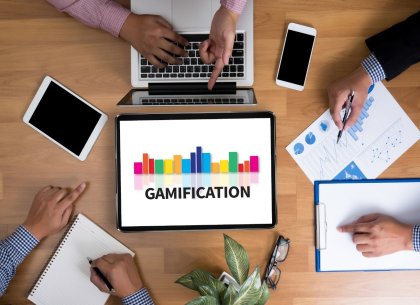We all love games and they form an important part of our lives. Whether it’s a game on a console or mobile, or its offline games are enjoyed and loved by children and adults alike. What if the fun element of a game could be incorporated into non-game situations to increase engagement..? This is where gamification comes into play. Gamification by definition refers to the inclusion of game like situations, such as keeping scores and points, rising up in levels by completing challenges,and being rewarded for the same in completely non game scenarios. The term gamification was coined by Nick Pelling in 2002 and has become increasingly popular in the recent years. The increasing use of gamification in business context is not surprising at all.Companies are employing this concept to motivate their staff and increase productivity and engagement.
Gamification is more psychology, less technology. Gamification does not literally mean you engage your customers or employees in a game. It is only an element of your application where other distinctive services arealso actively into play. Gamification is about taking the game elements (not full games) and the game thinking (not game technique) and applying them in a non-game environment.Gamification finds an attractive place here. Customers are rewarded with points for specific behavior (such as buying certain products, signing up or filling up their profile) and these points can be used to gain access to privileges and prizes. The psychology of winning prizes for certain achievable targets motivates and engages customers. It makes even the most mundane a lot of fun.
Applying Gamification to Business
Gamifying businesses has become the latest trend and rightly so. The motive behind is to increase productivity and raise worker engagement. Gamification of the workplace accomplishes a change in behavior of the employees – something that managers have struggled with traditionally. Most businesses have age old and redundant systems to motivate their workforce. An effort to engage employees almost always goes futile. Gamification infuses a new thrill and challenge into the employees, motivates them and increases theirproductivity. Our brain releases dopamine that brings in a rush of happiness whenever we achieve a goal. Gamification uses this simple fact to keep the user happy and motivated by achieving relevant and meaningful goals. Notifications when goals are achieved keep the users motivated and engaged.
Gamification Design and Framework
As with any marketing strategy, effective gamification needs an effective plan. It is important to keep in mind the business goals, the target audience and the target behavior.
A gamified system must essentially:
- Motivate the user to carry out an activity (points or rewards)
- Enable the user to complete the action
- Prompt the user to end the action
Gamification and website optimization
The popularity of gamification is growing rapidly with relation to providing better website experience. Website optimization is about improving website experience and in turn influencing the behavior of the visitors. When it becomes evident which behaviors can be encouraged, gamification can prove to be a very powerfultool and techniques can be applied to accomplish the goals. Using gamification, certain desired behaviors may be stimulated and various persuasion techniques can be applied to optimize the website.
Gamification can be used in many other fields besides online marketing. Gamification within business can be used successfully also for the following:
- Promotion
- Increasing Employee Productivity
- Behavior Change
- Loyalty
- Education
Gamification Strategies
Gamification strategies provide rewards for users who successfully accomplish the desired action to keep the users engaged. Rewards include points and privileges, achievement levels or even virtual currency. It is desirable and important to make the tasks and rewards of the accomplished user visible to engage and motivate more users to compete.
It is important to remember that every aspect of gamification does not appeal to every user. Different aspects of online learning and gamification appeal and motivate different kinds of people. Gamification online affects each of these types in a different way:
- Socializers: These users relate with other users at any level and enjoy interacting. Social interactions brought about by gamification are valuable to these users.
- Achievers:These users are motivated by a sense of competition. Points, rewards and leaderboards get them motivated to work and learn.
- Free spirits: Free spirits explore their environment and take pride in finding the extra functionalities before anyone else does it.
- Players: Players work in a similar way to achievers and are motivated by the rewards. The reward itself is not valuable to them but they want to clearly demonstrate how they achieved the reward.
It is thus of utmost importance to utilize gamification in a business strategy – badges will appeal to some users, progression levels to some others, and leaderboards will motivate the rest.
Objectives of Gamification in Business
It is clear that gamifying a business helps in attracting and engaging various users – from socializers to people who just want to help the others- and helps to achieve business objectives. From attraction and retention to motivation, engagement and productivity, gamification helps to tap user behavior and encourages them. Opening up options within the organization shows the user that business cares about them and offers more than just good training. Providing levels are a useful way to align gamification with business as they allow us to tailor each user’s growth to a set of parameters vital for success. Levels ensure that employees have gained the necessary knowledge to lead a team or gain a promotion.
Conclusion
It is well accepted now that gamification boosts employee as well as learner engagement and can transform a business or a training program into a great success. It can help businesses get the most out of their employees and create a company culture of empowerment and engagement that the company can be proud of.

